US Army badges are worn on a soldiers uniform. Some are worn on the day to day uniform (The OCP uniform), some are worn on the formal uniform (ASU’s) and some are worn on both uniforms. Maybe you have seen some of these badges on soldiers waling around or maybe in movies. Here I will break down some of the more common ones you might see and tell you what they represent.
![]()
The expert Infantryman badge, also refereed to as EIB, is a skill badge awarded to Infantrymen and soldiers in the Special Forces for completion of the EIB course which tests a soldiers proficiency in infantry skills. Those skills are tested in topics like:
- First Aid
- Chemical. Biological, Radiological, Nuclear (CBRN) procedures
- Call for fire (indirect Fire)
- Moving under fire and related tasks
- Communications
- Map reading/ GPS
- Weapons proficiency
- and more
Soldiers must also complete a 12 mile road march, score at least 80% in each event of the Physical fitness test and complete several other tasks. A soldier must receive a “GO” in each event to qualify. If a soldier dose not pass an event or receives a “NO-GO” then they will get a chance to try that event again in one hour. If they fail to pass the event after two attempts then they are dropped from the test completely. The test is conducted over a five day period.
The badge is worn above the US Army name tape on the OCP uniform and on the left above the soldiers ribons/medals on the ASU.

The Combat Infantryman badge, also known as the CIB, is awarded to Infantrymen and soldiers in the Special Forces that have fought in active ground combat. The badge was established in 1943. Requirements to receive the badge include:
- Be an infantryman satisfactorily performing infantry duties.
- Be assigned to an infantry unit during such time as the unit is engaged in active ground combat.
- Actively engage the enemy in ground combat.
A soldier can receive multiple awards which is represented by a star above the rifle for each additional award. A soldier with the CIB with two stars (3rd award) would be the highest you could see and even then it would not be on a soldier currently in the Army. It would still be rare to see a soldier currently in with one star (two awards) as they would have been in the Army for over 20 years now. That would not be on a young or a low ranking soldier. To receive the award a soldier would have had to engage in combat during one or more of the following qualified periods:
- World War II (7 December 1941 to 3 September 1945)
- Korea (27 June 1950 to 27 July 1953)
- Vietnam and other cold war era actions (2 March 1961 to 10 March 1995)
- War on Terror (5 December 2001 to present)
The badge is worn above the left breast pocket on the OCP uniform and on the left above the soldiers ribons/medals on the ASU.

The Combat Action Badge or CAB is awarded to soldiers that are not infantrymen, a part of the Special Forces or in the medical field (as they receive a Combat Medical Badge) and were present and actively engaging or being engaged by the enemy. The badge was established in 2005 to represent those soldiers that have been in combat and would not qualify for the Combat Infantryman badge or Combat Medical Badge.
The Combat Action badge is also different from the Combat Infantryman and Combat Medical badges as it can be awarded to soldiers of any rank, to include General Officers, where the CIB and CMB are both restricted to the ranks of Colonel and below.
The badge is worn above the left breast pocket on the OCP uniform and on the left above the soldiers ribons/medals on the ASU.

The Parachutist Badge, also known as “Jump Wings” or “silver wings” is a skill badge awarded to soldiers that complete the US Army Basic Airborne Course in Fort Benning, Georgia. There are three phases in the course that consist of a ground phase, tower phase and a jump phase that includes jumping out of a plane during the day and during the night.
A soldier can move from a Basic Parachutist Badge to more advance levels which have a slightly different badge such as Senior and Master Parachutist as well as add a combat Jump device for those that jumped into a combat zone.
The badge is worn above the left breast pocket on the OCP uniform and on the left breast pocket flap on the ASU.
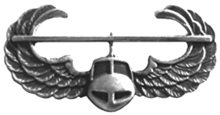
The Air Assault Badge is a skill badge awarded to soldiers that complete Air Assault School that is conducted at various Army installations. There are three phases at the school that include combat air assault operations (rotary wing/ helicopter), rigging and slingloading operations as well as reppelling from a helicopter.
The badge is worn above the left breast pocket on the OCP uniform and on the left breast pocket flap on the ASU.
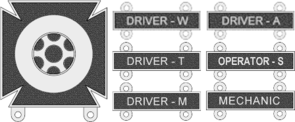
The Driver and Mechanic Badge is a skill badge that is awarded to drivers, mechanics and special equipment operators that achieve a high degree of skill in the operation and maintenance of motor vehicles. As an example for a soldier to receive a wheeled vehicle Drivers badge they must complete a operator course and be assigned as a driver for at least 12 months or drive 8,000 miles with no accidents or traffic violations.
The qualification received will be displayed with a clasp or bar hanging below the badge. Multiple bars can be linked if the soldier has revived the award for several qualifications. The specific clasps are as follows:
- DRIVER – A (for amphibious vehicles)
- DRIVER – M (for motorcycles)
- DRIVER – T (for tracked vehicles)
- DRIVER – W (for wheeled vehicles)
- MECHANIC (for automotive or allied vehicles)
- OPERATOR – S (for special mechanical equipment)
The badge is worn on the left breast pocket flap only on the ASU’s.
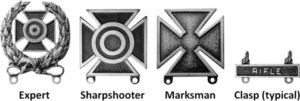
A Marksmanship Badge is presented to soldiers after they have successfully completed a weapons qualification course. Depending on how well the soldier qualifies will determine if they wear a marksman badge, Sharpshooter Badge or Expert Badge. The soldier then hangs a clasp or bar under the appropriate badge for the weapon they qualified with. A soldier can wear up to three marksmanship badges with no more than three clasps on each. Unlike the previous badges listed in this post, the Marksmanship Badge is not a permanent badge. If a soldier dose not qualify with a weapon in the required amount of time to periodically re-qualify (IE 6 months) then the soldier will have to remove the badge and or clasp from their uniform. Also if a soldier qualifies with a higher or lower score than their previous qualification, they will have to change the badge to the appropriate qualification level.
The badge is worn on the left breast pocket flap only on the ASU’s.
Some soldiers may wear Identification Badges to represent an additional duties they may have had in the Army. These badges represent that a soldier is currently or at some point was an Army recruiter, Drill Sergeant, Instructor, Career Counselor and several other badges.
These badges are worn on the right breast pocket of the soldier and is worn on both the OCP uniform and ASU.
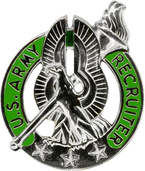
-Recruiter
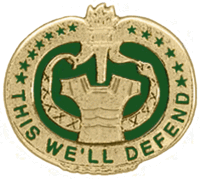
-Drill Sergeant
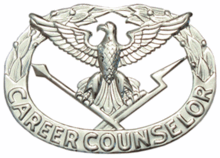 –Career Counselor
–Career Counselor
You can also check out the video explanation of badges in the Army by watching my video here:

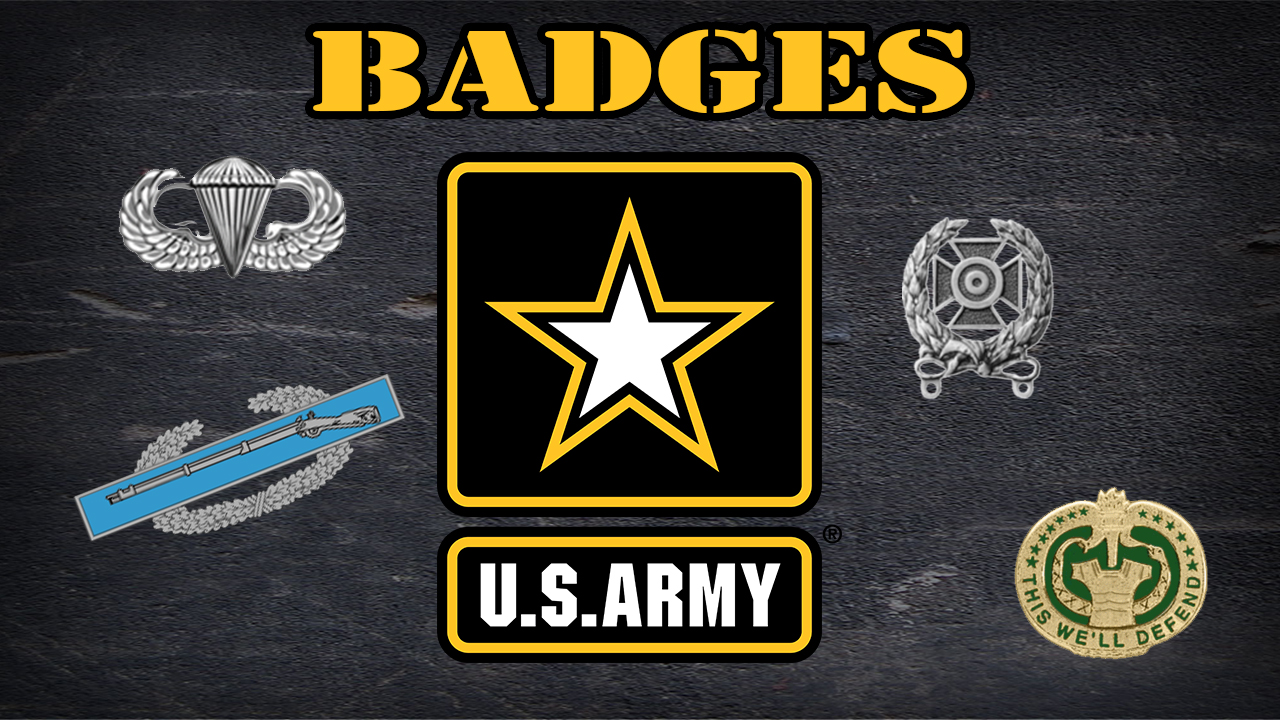
Leave a Reply